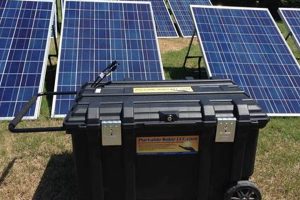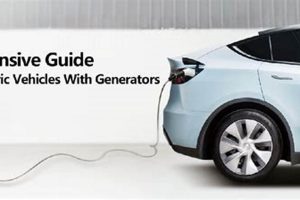Dual-voltage power sources offer both 120 and 240-volt outlets, enabling them to power a wide range of devices. This flexibility is achieved through a configuration that combines two 120-volt windings. Smaller appliances like lights and electronics can operate on the standard 120-volt circuits, while heavier-duty equipment, such as welders or larger power tools, can utilize the combined 240-volt output. This adaptability makes these power sources suitable for various applications, from job sites and recreational activities to emergency home backup power.
The availability of two voltage levels in a single, mobile unit significantly expands its utility. Historically, accessing both voltages often required multiple devices or complex wiring. The combined output makes these versatile units capable of handling both everyday needs and demanding tasks, reducing the need for separate generators. This feature is especially crucial in situations where a consistent and varied power supply is essential, such as during power outages or in remote locations.
Understanding the capabilities and applications of dual-voltage portable power is fundamental to selecting the right unit for specific needs. Factors such as power output, fuel type, and runtime are essential considerations, each influencing the unit’s suitability for different tasks. Further exploration of these aspects will provide a comprehensive overview of available options and their optimal usage scenarios.
Tips for Safe and Effective Dual-Voltage Generator Use
Operating portable generators safely and efficiently requires careful planning and adherence to recommended practices. The following tips offer guidance for maximizing the benefits of dual-voltage power sources while minimizing potential hazards.
Tip 1: Calculate Power Requirements: Determine the wattage needs of all devices intended for connection. This ensures the generator’s capacity meets the demand, preventing overload and potential damage.
Tip 2: Proper Grounding: Ensure the generator is properly grounded to protect against electrical shock. Consult the owner’s manual for specific grounding instructions.
Tip 3: Fuel Safety: Always refuel the generator outdoors and away from any ignition sources. Allow the engine to cool completely before adding fuel.
Tip 4: Ventilation: Operate the generator in a well-ventilated area to prevent carbon monoxide buildup. Never run a generator indoors or in enclosed spaces.
Tip 5: Connection Procedures: Follow manufacturer instructions precisely when connecting devices. Ensure proper voltage selection (120V or 240V) for each device.
Tip 6: Regular Maintenance: Perform routine maintenance as outlined in the owner’s manual. This includes oil changes, air filter cleaning, and spark plug replacement.
Tip 7: Storage Best Practices: Store the generator in a dry, protected location. Drain the fuel system before long-term storage to prevent fuel degradation.
Adhering to these safety and operational guidelines ensures reliable power delivery and extends the generator’s lifespan. Informed operation contributes to both user safety and efficient power utilization.
By understanding and implementing these practices, users can maximize the versatility and reliability of dual-voltage generators for a wide range of applications.
1. Power Output
Power output, measured in watts, represents a critical specification for dual-voltage portable generators. This metric directly dictates the number and type of devices that can be powered simultaneously. A generator’s power output must exceed the combined wattage requirements of all connected appliances to prevent overload and ensure safe, reliable operation. Understanding the relationship between power output and voltage is crucial. While a generator may provide both 120 and 240 volts, the available wattage is often distributed differently across these voltages. For instance, a generator with a 5000-watt running capacity might offer 4000 watts at 120 volts and the full 5000 watts at 240 volts. This distinction emphasizes the importance of calculating power needs at each voltage level to avoid exceeding the generator’s capacity on either circuit.
Consider a construction site requiring both power tools and lighting. High-power tools, such as circular saws or welders, typically operate at 240 volts and draw significant wattage. Simultaneously, multiple 120-volt lights and smaller tools may be necessary. In this scenario, accurately assessing the power requirements at both voltage levels is paramount. If the combined 120-volt load exceeds the generator’s designated 120-volt output, even if the total load is below the generator’s overall capacity, it could lead to circuit breaker trips or even generator damage. Conversely, connecting a large 240-volt load that exceeds the generator’s 240-volt capacity would similarly jeopardize functionality and safety.
Proper power output selection is therefore essential for effective generator utilization. Underestimating power needs can result in insufficient power supply, while overestimating can lead to unnecessary fuel consumption and higher purchase costs. Careful consideration of both overall wattage capacity and the specific power distribution across 120 and 240-volt circuits ensures optimal performance and safe operation of a dual-voltage portable generator. Accurately matching the generator’s output to the intended applications is fundamental to maximizing its utility and preventing potential hazards.
2. Dual-Voltage Functionality
Dual-voltage functionality is a defining characteristic of versatile portable generators, enabling them to power a wider range of devices compared to single-voltage units. This capability stems from the generator’s internal configuration, which typically includes two 120-volt windings that can be combined to provide 240 volts. This adaptability makes dual-voltage generators suitable for applications requiring both standard household power and higher-voltage demands.
- Powering Diverse Equipment:
Dual-voltage output allows a single generator to power devices with different voltage requirements. For instance, standard household appliances like refrigerators and lights can operate on 120 volts, while heavier-duty equipment like well pumps or air conditioners may require 240 volts. This eliminates the need for separate generators, streamlining power provision in various settings.
- Enhanced Flexibility in Applications:
Dual-voltage generators offer enhanced flexibility across diverse applications. On construction sites, they can power both 120-volt hand tools and 240-volt welders. For recreational activities, they can handle the needs of both 120-volt RV appliances and 240-volt power tools for repairs. During emergency power outages, they provide comprehensive backup power, supporting essential household systems.
- Wiring Configurations and Outlet Types:
Dual-voltage generators utilize specific wiring configurations and outlet types to deliver both voltage options. The 240-volt output often employs a dedicated outlet, such as a L14-30, while multiple 120-volt outlets, like standard 5-15R receptacles, provide household power. Understanding these configurations is crucial for safely connecting devices and maximizing the generator’s capabilities.
- Importance of Load Balancing:
Effective utilization of dual-voltage functionality requires careful load balancing. Distributing the power load evenly across both 120-volt circuits prevents overloading either circuit and optimizes generator performance. Uneven load distribution can lead to tripped breakers, reduced generator efficiency, and potential damage to connected devices.
The dual-voltage functionality inherent in these generators enhances their versatility significantly, making them essential power sources for diverse applications. From professional job sites and recreational pursuits to emergency preparedness, the ability to power a wide spectrum of devices from a single, portable unit highlights the practical advantages of dual-voltage technology. This adaptability combined with careful load management underscores their crucial role in providing reliable power wherever it is needed.
3. Portability
Portability is a defining feature of 120/240 volt generators, directly influencing their usability across various applications. The ability to easily transport these power sources determines their suitability for scenarios ranging from emergency home backup to remote job sites and recreational activities. Evaluating portability requires considering factors such as weight, dimensions, and integrated features that aid mobility.
- Weight and Dimensions:
The weight and dimensions of a portable generator directly impact its maneuverability. Lighter, more compact units are easier to transport and position, making them ideal for applications requiring frequent relocation. Heavier, bulkier generators, while often offering higher power output, may necessitate assistance or specialized equipment for transport. Manufacturers often provide specifications regarding weight and dimensions, enabling users to select a generator appropriate for their physical capabilities and transportation methods.
- Wheels and Handles:
Integrated features like wheels and handles significantly enhance portability. Never-flat wheels or larger pneumatic tires facilitate movement over uneven terrain commonly encountered on construction sites or outdoor recreational settings. Ergonomically designed handles, including telescoping handles for compact storage, contribute to easier handling and reduced strain during transport. The presence and design of these features are important considerations when evaluating a generator’s portability.
- Frame Design and Construction:
A robust frame design and durable construction are essential for protecting the generator during transport and ensuring long-term reliability. Frames constructed from heavy-duty materials like steel offer greater protection against impacts and vibrations encountered during movement. Compact frame designs that minimize the generator’s overall footprint enhance maneuverability in confined spaces. The frame design should also consider protection for vital components like the control panel and fuel tank.
- Impact on Application Suitability:
The degree of portability directly influences a generator’s suitability for various applications. Highly portable units are well-suited for camping, tailgating, and other recreational activities where ease of transport is paramount. Moderately portable generators might be suitable for small businesses or home backup power, where occasional relocation is necessary. Larger, less portable generators are typically reserved for stationary applications or scenarios where dedicated transport equipment is available.
Portability, therefore, is a critical factor in selecting a 120/240 volt generator. Careful consideration of weight, dimensions, integrated features, and intended applications ensures optimal usability and ease of transport. Balancing power output with portability requirements ensures the chosen generator meets the demands of the specific task while remaining manageable to transport and position as needed.
4. Fuel Type
Fuel type is a crucial consideration when selecting a 120/240 volt portable generator, impacting not only the generator’s operation but also its suitability for various applications. The choice of fuel influences factors such as runtime, maintenance requirements, environmental impact, and fuel availability, particularly in emergency situations. Understanding the characteristics of different fuel types is essential for informed generator selection.
- Gasoline:
Gasoline is a commonly used fuel for portable generators due to its widespread availability and relatively low cost. Gasoline-powered generators typically offer good power-to-weight ratios and generally require less complex maintenance compared to diesel or propane counterparts. However, gasoline has a shorter shelf life than other fuels and can degrade over time, potentially causing carburetor issues. Its volatility also poses storage and safety concerns.
- Propane:
Propane offers advantages in terms of fuel stability and extended shelf life. Propane-powered generators produce cleaner emissions compared to gasoline and often operate more quietly. Propane’s availability in readily portable tanks simplifies fuel management, making it convenient for recreational use. However, propane burns less efficiently than gasoline, potentially requiring larger fuel tanks for equivalent runtime. Cold weather can also affect propane vaporization, potentially impacting generator starting in extreme temperatures.
- Diesel:
Diesel-powered generators are known for their durability, fuel efficiency, and long operating life. Diesel fuel has a higher energy density than gasoline or propane, resulting in longer runtimes on a given volume of fuel. Diesel engines typically require less frequent maintenance compared to gasoline engines. However, diesel generators tend to be heavier and more expensive than gasoline or propane options, and they generally produce higher noise levels.
- Dual Fuel/Tri-Fuel:
Dual-fuel or tri-fuel generators offer enhanced versatility by allowing operation on multiple fuel types. Common combinations include gasoline/propane and gasoline/propane/natural gas. This flexibility provides fuel source options depending on availability and cost. Dual-fuel operation typically prioritizes one fuel type (e.g., propane) and automatically switches to a secondary fuel (e.g., gasoline) when the primary source is depleted. This automatic switchover feature provides extended runtime and minimizes disruption during prolonged power outages.
The choice of fuel type significantly impacts the overall functionality and suitability of a 120/240 volt portable generator for specific applications. Evaluating fuel availability, storage requirements, runtime needs, environmental considerations, and budget constraints are crucial factors influencing fuel type selection. A thorough assessment of these factors ensures the chosen generator aligns with individual needs and operating environments, maximizing its utility and efficiency.
5. Runtime
Runtime represents a critical performance metric for 120/240 volt portable generators, defining the duration a generator can operate continuously on a single fuel tank. This duration directly impacts the generator’s practicality for various applications, influencing its suitability for extended power outages, remote job sites, or recreational activities. Several factors influence a generator’s runtime, including fuel tank capacity, engine efficiency, and the load placed on the generator. Understanding these interconnected factors is essential for selecting a generator that meets specific power duration requirements.
Fuel tank capacity directly correlates with potential runtime. Larger fuel tanks generally provide longer runtimes, assuming consistent engine efficiency and load. However, larger tanks also increase the generator’s overall size and weight, potentially impacting portability. Engine efficiency plays a significant role in determining how effectively fuel is converted into usable power. More efficient engines extract more energy from a given volume of fuel, extending runtime. The load placed on the generator also significantly impacts runtime. Higher power demands consume fuel more rapidly, reducing the overall operating duration. Operating the generator at a lower load, by only powering essential devices, can significantly extend runtime.
Consider a scenario where a generator is needed for an extended power outage. A generator with a small fuel tank and powering numerous appliances will have a significantly shorter runtime compared to a generator with a larger fuel tank powering only essential devices. Similarly, on a construction site, a generator powering multiple power tools will deplete its fuel supply faster than a generator powering a single tool. For recreational activities, a generator with a longer runtime ensures consistent power throughout a camping trip or outdoor event. Understanding the interplay between fuel tank capacity, engine efficiency, load management, and runtime is crucial for selecting the appropriate generator and optimizing its operational duration to meet specific power needs. Accurately assessing these factors ensures reliable power availability for the required timeframe.
6. Safety Features
Safety features are integral components of 120/240 volt portable generators, designed to mitigate potential hazards associated with electricity generation and fuel combustion. These features protect both the generator itself and the individuals operating or utilizing the power it produces. Overload protection, implemented through circuit breakers or fuses, prevents damage to the generator’s electrical system by interrupting power flow in the event of excessive current draw. This safeguard prevents overheating and potential fires caused by overloaded circuits. Low-oil shutdown mechanisms automatically shut down the engine when oil levels fall below a critical threshold, preventing engine damage caused by insufficient lubrication. This feature protects the generator’s core components and extends its operational lifespan.
Consider a scenario where multiple power tools are connected to a 120/240 volt generator. If the combined power draw of these tools exceeds the generator’s rated capacity, the overload protection system will activate, preventing damage to the generator’s electrical components. Similarly, if the generator’s oil level drops significantly due to a leak or neglect, the low-oil shutdown feature will activate, preventing catastrophic engine failure. These safety features not only protect the generator but also prevent potential fire hazards and equipment malfunctions that could pose risks to users. Furthermore, features like carbon monoxide detectors and automatic shutoff valves contribute to user safety by mitigating the risks associated with carbon monoxide poisoning, a significant hazard associated with fuel-burning appliances.
In conclusion, integrated safety features are essential for safe and reliable operation of 120/240 volt portable generators. These features prevent damage to the generator, protect connected devices, and mitigate potential hazards to users. Understanding the function and importance of these safety mechanisms contributes to informed operation, ensuring both equipment longevity and user safety in diverse applications.
Frequently Asked Questions
This section addresses common inquiries regarding dual-voltage portable generators, providing concise and informative responses to clarify key aspects of their selection, operation, and maintenance.
Question 1: What distinguishes a dual-voltage generator from a single-voltage unit?
Dual-voltage generators offer both 120 and 240-volt outlets, accommodating a wider range of devices. Single-voltage generators provide only one voltage output, typically 120 volts.
Question 2: How is the wattage distributed across the 120 and 240-volt outlets?
Wattage distribution varies by model. Consult the generator’s specifications to determine the available wattage at each voltage. The combined wattage should not exceed the generator’s total rated output.
Question 3: What fuel types are commonly used in these generators?
Gasoline, propane, and diesel are common fuel types. Some models offer dual-fuel or tri-fuel capabilities for increased flexibility.
Question 4: How is runtime affected by load and fuel tank capacity?
Higher loads decrease runtime. Larger fuel tanks generally provide longer runtimes, but actual duration depends on load and engine efficiency.
Question 5: What safety features are typically included?
Common safety features include overload protection (circuit breakers), low-oil shutdown, and carbon monoxide detection systems.
Question 6: How does one determine the appropriate generator size for specific needs?
Calculate the combined wattage requirements of all intended devices. Select a generator with a running wattage output exceeding this calculated load.
Understanding these fundamental aspects of dual-voltage portable generators empowers informed decision-making regarding selection, operation, and maintenance. Careful consideration of these elements ensures safe and efficient power delivery for diverse applications.
For further information and detailed specifications, consult individual product manuals and manufacturer resources.
120/240 Volt Portable Generators
Dual-voltage portable generators offer versatile power solutions for various applications, from construction sites and emergency preparedness to recreational activities. This exploration has highlighted key aspects of these generators, encompassing power output, dual-voltage functionality, portability considerations, fuel type options, runtime estimations, and essential safety features. Understanding these elements is crucial for selecting the appropriate generator to meet specific power demands efficiently and safely. Careful consideration of load requirements, fuel efficiency, and safety mechanisms ensures optimal performance and mitigates potential hazards.
Effective power management remains essential in an increasingly electrified world. Portable generators provide critical support during grid disruptions and enable productivity in off-grid locations. Informed selection and responsible operation of these power sources are crucial for maximizing their benefits and ensuring long-term reliability. Further research and consultation with industry experts will provide additional insights into emerging technologies and best practices for portable power utilization.






